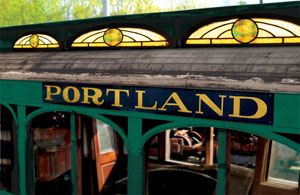Summerguide 2014 | view this story as a .pdf
More precisely, it’s an interurban train. Ken Burns is making it a star.
By Patricia Erikson
 Elegant ride for the ‘Rough Rider’
Elegant ride for the ‘Rough Rider’
Before producing the 14-hour documentary series The Roosevelts: An Intimate History, legendary filmmaker Ken Burns tracked down the Roosevelts’ favorite haunts in Maine, everywhere from Mount Katahdin to Eleanor and F.D.’S compound at Campobello Island. Theodore “Teddy” Roosevelt, Jr., in particular, felt lifelong affection for Maine. Burns says, “Maine was a special place for Teddy. In our series, we show that after suffering personal loss, including the death of his father in 1878, Teddy found a world in which to restore himself in the wilderness of Maine.” Roosevelt pined for Maine’s wilderness throughout his life. Yet a valuable artifact at Seashore Trolley Museum in Arundel reveals that, more often than not, his trips to Maine involved the grit and glamor of a campaign trail more than flannel and campfire.
In particular, an electric railroad coach at Seashore Trolley Museum brings Teddy Roosevelt’s pine-tree excursions alive. The Narcissus–once a high-speed engineering marvel–bears the celebrity of having transported Theodore Roosevelt Jr. between Lewiston and Portland on August 18, 1914. Less than a month after the Portland-Lewiston Interurban line (PLI) opened to acclaim as Maine’s fastest and finest electric railway, Teddy stepped up to the glossy green coach, climbed through an elegantly arched doorway, and took one of the plush green seats, most likely avoiding the smoking compartment, where his traveling companions puffed on cigars.
Whether one knew him as Teddy, the Rough Rider, or the 26th president of the United States, Roosevelt’s goings and comings in Maine generated considerable fanfare. That summer of 1914, Austria-Hungary had just declared war on Serbia, but the First World War had not yet been dubbed as such. Newspaper reports of Roosevelt’s visit focused on more local concerns–namely, the crowds that gathered and cheered at stations along the way. The New York Times relates how, as Narcissus slowed from as much as 70 mph to navigate a curve, a pretty girl ran out of a nearby farmhouse, tossing a bouquet of flowers into the rear of the car. Roosevelt jumped from his seat and, with a broad smile, waved the bouquet above his head.
As entrenched in automobile transportation as we are today, it’s still difficult to comprehend that a century ago, Roosevelt traveled between Portland and Lewiston at speeds exceeding the Downeaster. It’s also hard to imagine how the former president would have gazed at the passing Maine landscape through the Narcissus’s stained-glass windows, framed by mahogany paneling with gilded striping and inlaid with holly and ebony.
One of six luxury interurban cars, all named for flowers, Narcissus served two decades. Then it careened from the foreclosure sale of the PLI in 1933 to an inglorious service as a family “camp” in Sabattus. In 1969, the museum liberated Narcissus by building its owner a new camp. Transported by truck bed to the museum, it made its way into the permanent collection and, in 1980, onto the U.S. National Register of Historic Places.
Interurban Cowboys
Awaiting restoration for nearly half a century while the museum restored dozens of other vintage vehicles, Narcissus has entered a new chapter of its history. Museum volunteers in the Townhouse Restoration Shop have been restoring the more than two dozen arched, mahogany windows, both the slender clerestory and deeper, eyebrow-shaped ones. Phil Morse, Narcissus Project Manager, says, “This year is the 75th anniversary of the museum. It’s an ideal time to visit and experience the living history here by riding our operating streetcars. Museum visitors share stories and photographs that reveal colorful family histories associated with these streetcars. We hold these artifacts in public trust, but we also help people relive that history.”





0 Comments